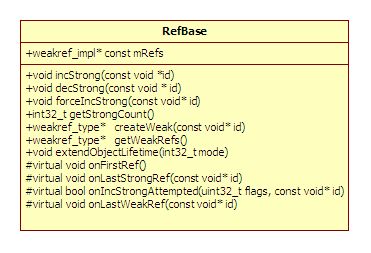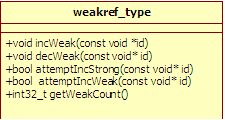1关于C++ Layer的内存回收机制
Android C++层的内存收回主要是通过三个类来实现,分别是RefBase,sp,wp;
SP和WP是两个智能指针模板类,sp是strong pointer,wp则是weak pointer,亦我们常说的强引用和弱引用;实例化sp和wp这两个模板类的类型必须是派生自RefBase的类
1.1 RefBase类
因为这个类拥有对内存回收机制的默认实现,所以android上想要支持内存回收机制的类必须派生自RefBase

下面简单介绍下成员变量和成员函数:
mRefs:
weakref_impl对象,派生于RefBase::weakref_type, 包含了对strong ref和weak ref的具体实现,也就是说RefBase中只包含了一些对外的标准操作,具体的实现在weakref_impl内
void incStrong(const void *id):
强引用计数加1,参数id主要用在debug时跟踪调试,一般都为sp或者wp的对象指针
void decStrong(const void *id):
强引用计数减1,参数id含义同上
void forceIncStrong(const void *id):
强制引用计数加1
Int32_t getStrongCount():
获去强引用计数值
weakref_type * createWeak(const void *id)
弱引用计数加1,然后返回weakref_impl对象
weakref_type* getWeakRefs()
获取weakref_impl对象
void extendObjectLifetime(int32_t mode):
扩展对象的生命期,默认为0,可设置为
OBJECT_LIFETIME_WEAK = 0x0001,
OBJECT_LIFETIME_FOREVER = 0x0003
这几个参数的作用在下面会详细描述
virtual void onFirstRef()
虚函数,在第一次新增引用计数时,会调用此函数,接下去的其他函数都类似
上面也有提到了,RefBase有一个内部基类weakref_type,

它主要包含了对弱引用计数的基本操作,
void incWeak(const void*id):
弱引用计数加1,id参数的意义同上
void decWeak(const void *id):
弱引用计数减1,id同上
bool attemptIncStrong(const void *id):
尝试增加强引用计数,这个函数会在wp promote获取sp时被调用,主要确认wp promote为sp是否成功
bool attemptIncWeak(const void *id):
尝试增加弱引用计数,这个功能只在object lifetime设置为OBJECT_LIFETIME_FOREVER有效
Int32_t getWeakCount():
获取弱引用计数值
在RefBase中,可以通过extendObjectLifetime来设置lifetime,有三种life time:
1:default(0),强引用和弱引用的默认行为,不管弱应用计数的值为多少,只要强引用计数的值为0,就释放对象
2:OBJECT_LIFETIME_WEAK,在这种状态下,如果强引用为0时,对象不会被释放,只有在弱引用计数为0的情况下,对象才会被释放
3:OBJECT_LIFETIME_WEAK | OBJECT_LIFETIME_FOREVER,在这种状态下,对象永不会释放
第三种情况比较猛,设置了,除非主动delete raw pointer,否则在sp和wp的规则下,是不会被释放的,当然,promote也是永远都会成功的
在增加或者减少强引用计数的同时,弱引用计数也会被增加或减少,它们总是配对出现的,下面简单看下几个关键部分的代码:
//增加强引用计数
01 |
void RefBase::incStrong(const void* id) const |
05 |
weakref_impl* const refs = mRefs; |
17 |
refs->addStrongRef(id); |
19 |
const int32_t c = android_atomic_inc(&refs->mStrong); |
21 |
LOG_ASSERT(c > 0, "incStrong() called on %p after last strong ref", refs); |
25 |
LOGD("incStrong of %p from %p: cnt=%d\n", this, id, c); |
29 |
if (c != INITIAL_STRONG_VALUE) { |
41 |
android_atomic_add(-INITIAL_STRONG_VALUE, &refs->mStrong); |
45 |
const_cast<RefBase*>(this)->onFirstRef(); |
//增加弱引用计数
01 |
void RefBase::weakref_type::incWeak(const void* id) |
05 |
weakref_impl* const impl = static_cast<weakref_impl*>(this); |
11 |
const int32_t c = android_atomic_inc(&impl->mWeak); |
13 |
LOG_ASSERT(c >= 0, "incWeak called on %p after last weak ref", this); |
接下是两个减少引用计数的函数,因为这两个函数涉及到对象的销毁,所以讲的详细点
//减少强引用计数
01 |
void RefBase::decStrong(const void* id) const |
05 |
weakref_impl* const refs = mRefs; |
07 |
refs->removeStrongRef(id); |
09 |
const int32_t c = android_atomic_dec(&refs->mStrong); |
13 |
LOGD("decStrong of %p from %p: cnt=%d\n", this, id, c); |
17 |
LOG_ASSERT(c >= 1, "decStrong() called on %p too many times", refs); |
23 |
const_cast<RefBase*>(this)->onLastStrongRef(id); |
27 |
if ((refs->mFlags&OBJECT_LIFETIME_WEAK) != OBJECT_LIFETIME_WEAK) { |
35 |
refs->removeWeakRef(id); |
//减少弱引用计数
01 |
void RefBase::weakref_type::decWeak(const void* id) |
05 |
weakref_impl* const impl = static_cast<weakref_impl*>(this); |
07 |
impl->removeWeakRef(id); |
09 |
const int32_t c = android_atomic_dec(&impl->mWeak); |
11 |
LOG_ASSERT(c >= 1, "decWeak called on %p too many times", this); |
17 |
if ((impl->mFlags&OBJECT_LIFETIME_WEAK) != OBJECT_LIFETIME_WEAK) { |
21 |
if (impl->mStrong == INITIAL_STRONG_VALUE) |
39 |
impl->mBase->onLastWeakRef(id); |
41 |
if ((impl->mFlags&OBJECT_LIFETIME_FOREVER) != OBJECT_LIFETIME_FOREVER) { |
如果对上面一会释放imple->mBase,一会释放weakref_impl有疑问,继续看RefBase的析构函数:
05 |
if (mRefs->mWeak == 0) { |
RefBase被销毁时,只有当弱引用计数为0时,才会释放weakref_imp对象,上面decWeak中第一和第三个delete,直接释放impl->mBase,肯定没问题,因为这时候弱引用计数已经为0,weakref_imp对象在析构中正常被释放
再看第二个delete,在默认life time下,如果RefBase通过sp建立了强引用,在强引用为0的情况下在执行RefBase::decStrong中的以下代码,
if ((refs->mFlags&OBJECT_LIFETIME_WEAK) != OBJECT_LIFETIME_WEAK) {
delete this;
}
RefBase对象肯定会被释放,在释放时调用析构时,由于mRefs->mWeak == 0不成立,内部weaktype_imp对象不会被释放,所以这里需要delete impl以释放内部引用管理对象
1.2 创建sp和wp对象
创建sp:
sp(T* other):直接使用Raw pointer来创建sp对象
sp(const sp<T>& other):从已有的sp对象拷贝构造
创建wp:
wp(T* other):直接使用raw pointer来创建wp对象
wp(const wp<T>& other):从已有的wp对象拷贝
wp(const sp<T>& other):从已有的sp对象拷贝
1.3 关于promote
如果想通过已有的wp对象获取对应的内建对象,需要调用promote来尝试提升为sp,然后通过sp来判断promote是否成功,如果成功,说明内建对象还存在,可以继续使用,反之,需要创建新的内建对象
下面来详细查看下promote做了哪些操作:
03 |
sp<T> wp<T>::promote() const |
09 |
return sp<T>(m_ptr, m_refs); |
17 |
sp<T>::sp(T* p, weakref_type* refs) |
19 |
: m_ptr((p && refs->attemptIncStrong(this)) ? p : 0) |
调用引用管理类的函数attemptIncStrong来尝试增加强引用计数,如成功,说明raw pointer保存的对象还未被释放,可以继续使用,反之,返回false,promote失败
接下去详细看下attemptIncStrong的实现:
bool RefBase::weakref_type::attemptIncStrong(const void* id)
{
incWeak(id);
weakref_impl* const impl = static_cast<weakref_impl*>(this);
int32_t curCount = impl->mStrong;
LOG_ASSERT(curCount >= 0, "attemptIncStrong called on %p after underflow",
this);
//如果强引用计数不为初始值并且大于0,说明对象还活着,赶紧将引用计数+1
while (curCount > 0 && curCount != INITIAL_STRONG_VALUE) {
if (android_atomic_cmpxchg(curCount, curCount+1, &impl->mStrong) == 0) {
break;
}
curCount = impl->mStrong;
}
//如果强引用计数<=0或者初始值,就代表对象已经被释放了吗?
//不一定
if (curCount <= 0 || curCount == INITIAL_STRONG_VALUE) {
bool allow;
if (curCount == INITIAL_STRONG_VALUE) {
// attempting to acquire first strong reference... this is allowed
// if the object does NOT have a longer lifetime (meaning the
// implementation doesn't need to see this), or if the implementation
// allows it to happen.
/*curCount为初始值,说明sp未被创建,从一开始都是wp独自掌管,这种情况下,对象肯定存在,剩下就是根据程序需要,让不让它promote成功
根据以下代码,有两种情况:
1:生命期不为OBJECT_LIFETIME_WEAK,这时第一判断为true,onIncStrongAttempted结果忽略,allow为true
2:生命期为OBJECT_LIFETIME_WEAK时,这时就要看onIncStrongAttempted的结果了,默认该函数返回都为true,也就是说,程序的默认行为,allow都为true;当然你也可以在自己的类中
根据需要修改onIncStrongAttempted的默认行为来控制是否允许在这种情况下让其promote成功*/
allow = (impl->mFlags&OBJECT_LIFETIME_WEAK) != OBJECT_LIFETIME_WEAK
|| impl->mBase->onIncStrongAttempted(FIRST_INC_STRONG, id);
} else {
// Attempting to revive the object... this is allowed
// if the object DOES have a longer lifetime (so we can safely
// call the object with only a weak ref) and the implementation
allow = (impl->mFlags&OBJECT_LIFETIME_WEAK) == OBJECT_LIFETIME_WEAK
&& impl->mBase->onIncStrongAttempted(FIRST_INC_STRONG, id);
}
//不允许, promote失败
if (!allow) {
decWeak(id);
return false;
}
curCount = android_atomic_inc(&impl->mStrong);
// If the strong reference count has already been incremented by
// someone else, the implementor of onIncStrongAttempted() is holding
// an unneeded reference. So call onLastStrongRef() here to remove it.
// (No, this is not pretty.) Note that we MUST NOT do this if we
// are in fact acquiring the first reference.
if (curCount > 0 && curCount < INITIAL_STRONG_VALUE) {
impl->mBase->onLastStrongRef(id);
}
}
impl->addWeakRef(id);
impl->addStrongRef(id);
#if PRINT_REFS
LOGD("attemptIncStrong of %p from %p: cnt=%d\n", this, id, curCount);
#endif
if (curCount == INITIAL_STRONG_VALUE) {
android_atomic_add(-INITIAL_STRONG_VALUE, &impl->mStrong);
impl->mBase->onFirstRef();
}
return true;
}
attemptIncStrong成功,promote成功,继续使用已有的Refbase对象实例,如果失败了,则需重新创建新的对象。
1.4 用处
在android中,在实现基于RefBase的类中,大部分都使用默认的生命期,只有BpBinder会调用 extendObjectLifetime(OBJECT_LIFETIME_WEAK)来更改默认生命期;针对默认生命期,其用处和java的强引用和 弱引用类似。

